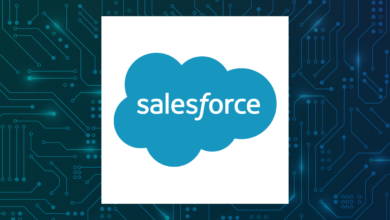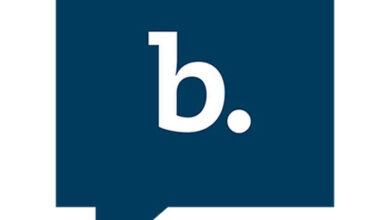Could Confluent Become the Next Salesforce?

Confluent (NASDAQ: CFLT) and Salesforce (NYSE: CRM) both help companies analyze data with their cloud-based platforms. Confluent’s platform processes “data in motion” in real time as it streams between applications. Salesforce is a much larger company that operates the world’s largest cloud-based customer relationship management (CRM) platform. Salesforce also provides other e-commerce, marketing, analytics, data visualization, and enterprise collaboration services.
Confluent was originally a division of LinkedIn before it was spun out as an independent company in 2014. It went public in 2021, but it now trades nearly 20% below its initial public offering (IPO) price with a market cap of $9 billion. Salesforce, which went public nearly 20 years ago, has rallied nearly 10,900% from its IPO price and is valued at $293 billion.

Confluent is still a tiny company compared to Salesforce, but could it evolve and expand into a comparable cloud giant over the next decade? Let’s review its business model, growth potential, and valuations to find out.
What does Confluent do?
Confluent’s namesake cloud service runs on top of Apache Kafka, an open source software platform that was originally created at LinkedIn to process its streaming data and messages in real time. Its developers subsequently founded Confluent to provide Kafka as a cloud-based service to other companies.
In its S-1 filing, Confluent set a goal for becoming the “central nervous system for modern digital enterprises” by making “data in motion core to everything they do.” Unlike many other analytics platforms that only process static data points, Confluent bundles Kafka with other cloud-based data-processing tools to analyze streaming data.
Confluent established a first-mover advantage in its Kafka-as-a-service space because it was founded by the platform’s original developers. But Confluent doesn’t have much of a moat because it’s still an open source platform that can be easily adopted by other cloud-based software companies. Amazon Web Services and Microsoft Azure both bundle Kafka-as-a-service tools into their market-leading cloud infrastructure platforms, and companies can directly integrate Kafka into their software ecosystems without signing up for Confluent’s services.
How much larger can Confluent grow?
From 2020 to 2023, Confluent’s revenue grew at a compound annual growth rate (CAGR) of 49%. Its total number of large customers (those that generated more than $100,000 in annual recurring revenue) more than doubled from 513 to 1,229.
But from 2023 to 2026, analysts expect Confluent’s revenue to rise at a CAGR of 24% as it remains unprofitable on a generally accepted accounting principles (GAAP) basis. Some of that slowdown can be attributed to macro headwinds, but the company could also be struggling to expand beyond its niche and keep pace with larger competitors.
A looming challenge is the saturation of the Kafka-as-a-service market. More than 80% of Fortune 100 companies already use Kafka, so Confluent needs to roll out more features to grow its revenue per customer. To do that, it needs to make some bold investments and acquisitions, like its $100 million purchase of the German data streaming start-up Immerok last year. But those expenses could delay its goal of achieving a breakeven non-GAAP operating margin in 2024.
According to Maximize Market Research, the global event stream processing market could expand at a CAGR of 21% from 2023 to 2029. If Confluent merely keeps pace with that market, its revenue could rise from $777 million in 2023 to $2.4 billion in 2029. If the company hits that target and continues growing at a CAGR of 20% from 2029 to 2034, it could generate $6 billion in revenue by the final year — which would be comparable to Salesforce’s revenue of $6.7 billion back in fiscal 2016 (ended in January 2016). From fiscal 2016 to fiscal 2024, Salesforce’s revenue increased at a CAGR of 23% to $34.9 billion as it fended off its competitors and expanded its ecosystem with several big acquisitions.
Could Confluent become the next Salesforce?
It’s too early to tell if Confluent can become the next Salesforce, but there are a few striking similarities. They both operate cloud-based software platforms, and they were both built on open source bones that were customized with stickier proprietary features. Confluent is also growing at a similar rate as a younger Salesforce, and it leads its niche market in the same way Salesforce conquered the cloud-based CRM market.
For now, investors should see if Confluent can maintain its lead, increase the stickiness of its platform, and balance its investments with its cost-cutting strategies. If it checks all those boxes, Confluent might just have a shot at growing into a much larger company.
Should you invest $1,000 in Confluent right now?
Before you buy stock in Confluent, consider this:
The Motley Fool Stock Advisor analyst team just identified what they believe are the 10 best stocks for investors to buy now… and Confluent wasn’t one of them. The 10 stocks that made the cut could produce monster returns in the coming years.
Stock Advisor provides investors with an easy-to-follow blueprint for success, including guidance on building a portfolio, regular updates from analysts, and two new stock picks each month. The Stock Advisor service has more than tripled the return of S&P 500 since 2002*.
*Stock Advisor returns as of April 8, 2024
John Mackey, former CEO of Whole Foods Market, an Amazon subsidiary, is a member of The Motley Fool’s board of directors. Leo Sun has positions in Amazon. The Motley Fool has positions in and recommends Amazon, Confluent, Microsoft, and Salesforce. The Motley Fool recommends the following options: long January 2026 $395 calls on Microsoft and short January 2026 $405 calls on Microsoft. The Motley Fool has a disclosure policy.
Could Confluent Become the Next Salesforce? was originally published by The Motley Fool



